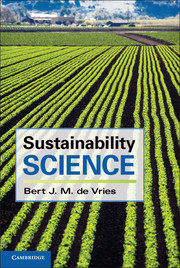Book contents
- Frontmatter
- Contents
- Preface
- 1 Introduction
- 2 The System Dynamics Perspective
- 3 In Search of Sustainability: Past Civilisations
- 4 The World in the Past 300 Years: The Great Acceleration
- 5 Sustainability: Concerns, Definitions, Indicators
- 6 Quality of Life: On Values, Knowledge and Worldviews
- 7 Energy Fundamentals
- 8 On Knowledge and Models
- 9 Land and Nature
- 10 Human Populations and Human Behaviour
- 11 Agro-Food Systems
- 12 Renewable Resources: Water, Fish and Forest
- 13 Non-Renewable Resources: The Industrial Economy
- 14 Towards a Sustainable Economy?
- 15 Outlook on Futures
- Glossary
- References
- Index
- Plate Section
- References
4 - The World in the Past 300 Years: The Great Acceleration
Published online by Cambridge University Press: 05 January 2013
- Frontmatter
- Contents
- Preface
- 1 Introduction
- 2 The System Dynamics Perspective
- 3 In Search of Sustainability: Past Civilisations
- 4 The World in the Past 300 Years: The Great Acceleration
- 5 Sustainability: Concerns, Definitions, Indicators
- 6 Quality of Life: On Values, Knowledge and Worldviews
- 7 Energy Fundamentals
- 8 On Knowledge and Models
- 9 Land and Nature
- 10 Human Populations and Human Behaviour
- 11 Agro-Food Systems
- 12 Renewable Resources: Water, Fish and Forest
- 13 Non-Renewable Resources: The Industrial Economy
- 14 Towards a Sustainable Economy?
- 15 Outlook on Futures
- Glossary
- References
- Index
- Plate Section
- References
Summary
Introduction
Although past civilisations are a source of imagination and insight, present-day concern about (un)sustainability is anchored largely in the exponential growth of population and economic activity in the last few centuries. These growth processes are part of what is known as the Industrial Revolution. Industrialisation occurred in many places throughout Western Europe at roughly the same time, although with locally specific features. It is rooted in the commercial and trade capitalism of medieval Europe (Braudel 1979). A series of events and trends since 1700 mutually interacted and boosted manufacturing and trading of goods in a successful mixture of science, technology and capitalism. It reinforced the process of European colonial expansion. The European ‘offshoots’ in America and Australia underwent similar transformations as Europe. A collectivist form of industrialisation took place in Russia after the revolution. The larger part of the human population, however, still lived a traditional agricultural life at modest levels of population growth and economic output until the middle of the 20th century. Only after 1950, they started to experience similar processes of change.
This chapter explores in some detail the important changes that came with the Industrial Revolution and modernity. Perhaps Churchill was right when he said, ‘The further backward you look, the further forward you can see’. In any event, some knowledge and understanding of what happened in the last 300 years is essential for an interpretation of our present situation and an exploration of what a sustainable future might look like. For that reason, I briefly survey demographic and economic trends, aspects of governance and globalisation, and socio-cultural trends. In the last section, two generic concepts are introduced as descriptive tools that can put the changes in a different perspective. The topic is vast, so I refer the reader to the suggested literature for further reading.
- Type
- Chapter
- Information
- Sustainability Science , pp. 84 - 116Publisher: Cambridge University PressPrint publication year: 2012



